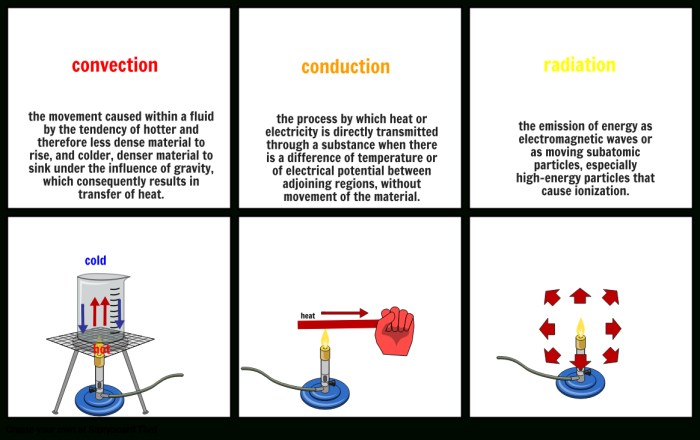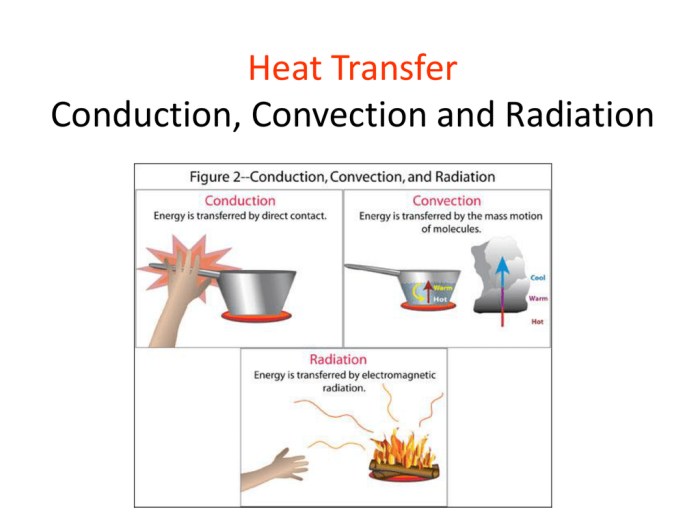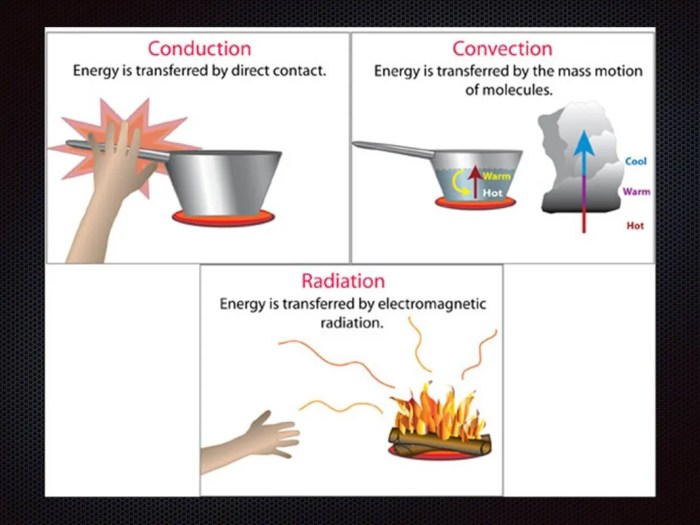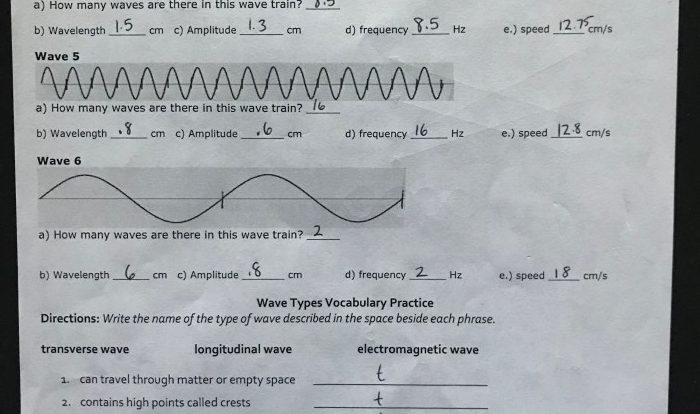Conduction convection radiation worksheet answers – Embark on a scientific expedition with our comprehensive “Conduction, Convection, Radiation Worksheet Answers,” a definitive guide that illuminates the enigmatic world of heat transfer. Delve into the intricacies of conduction, convection, and radiation, unraveling their distinct mechanisms and practical applications in our daily lives.
Prepare to grasp the fundamental principles that govern heat flow, empowering you to navigate thermal phenomena with newfound clarity. Our expert analysis and meticulously crafted explanations will guide you through a transformative learning experience, leaving an indelible mark on your understanding of heat transfer.
Conduction

Conduction is the transfer of heat through direct contact between two objects. When two objects with different temperatures come into contact, the heat flows from the hotter object to the cooler object until they reach the same temperature. Conduction is a slow process, and the rate of heat transfer depends on the following factors:
- Temperature difference between the objects
- Surface area in contact
- Material of the objects
Examples of conduction include:
- Heat flowing from a hot pan to a cold spoon
- Heat flowing from a warm hand to a cold surface
- Heat flowing from the sun to the Earth
Convection: Conduction Convection Radiation Worksheet Answers

Convection is the transfer of heat through the movement of a fluid. When a fluid is heated, it becomes less dense and rises. The cooler, denser fluid then flows in to take its place. This creates a convection current, which carries heat away from the heat source.
Convection is a more efficient way of transferring heat than conduction, and the rate of heat transfer depends on the following factors:
- Temperature difference between the fluid and the surroundings
- Density of the fluid
- Viscosity of the fluid
Examples of convection include:
- Heat rising from a fire
- Wind blowing over a warm surface
- Ocean currents
Radiation
Radiation is the transfer of heat through electromagnetic waves. All objects emit electromagnetic radiation, but the amount and type of radiation emitted depends on the temperature of the object. The hotter an object is, the more radiation it emits. Radiation is a very efficient way of transferring heat, and the rate of heat transfer depends on the following factors:
- Temperature of the object
- Surface area of the object
- Distance between the object and the receiver
Examples of radiation include:
- Heat from the sun
- Heat from a fire
- Heat from a light bulb
Worksheet Answers
Question 1: What is conduction?
Answer:Conduction is the transfer of heat through direct contact between two objects.
Question 2: What are some examples of conduction?
Answer:Some examples of conduction include heat flowing from a hot pan to a cold spoon, heat flowing from a warm hand to a cold surface, and heat flowing from the sun to the Earth.
Question 3: What factors affect the rate of conduction?
Answer:The factors that affect the rate of conduction are the temperature difference between the objects, the surface area in contact, and the material of the objects.
Question 4: What is convection?
Answer:Convection is the transfer of heat through the movement of a fluid.
Question 5: What are some examples of convection?
Answer:Some examples of convection include heat rising from a fire, wind blowing over a warm surface, and ocean currents.
Question 6: What factors affect the rate of convection?
Answer:The factors that affect the rate of convection are the temperature difference between the fluid and the surroundings, the density of the fluid, and the viscosity of the fluid.
Question 7: What is radiation?
Answer:Radiation is the transfer of heat through electromagnetic waves.
Question 8: What are some examples of radiation?
Answer:Some examples of radiation include heat from the sun, heat from a fire, and heat from a light bulb.
Question 9: What factors affect the rate of radiation?
Answer:The factors that affect the rate of radiation are the temperature of the object, the surface area of the object, and the distance between the object and the receiver.
Comparison of Conduction, Convection, and Radiation

| Process | Examples | Factors affecting the rate |
|---|---|---|
| Conduction | Heat flowing from a hot pan to a cold spoon | Temperature difference between the objects, surface area in contact, material of the objects |
| Convection | Heat rising from a fire | Temperature difference between the fluid and the surroundings, density of the fluid, viscosity of the fluid |
| Radiation | Heat from the sun | Temperature of the object, surface area of the object, distance between the object and the receiver |
Common Queries
What is the key difference between conduction and convection?
Conduction involves heat transfer through direct contact between objects, while convection involves heat transfer through the movement of fluids (liquids or gases).
Can radiation occur in a vacuum?
Yes, radiation is a form of electromagnetic energy that can travel through a vacuum, unlike conduction and convection which require a medium.
How does the rate of heat transfer by radiation depend on temperature?
The rate of heat transfer by radiation increases significantly with increasing temperature, following the fourth power of absolute temperature.
